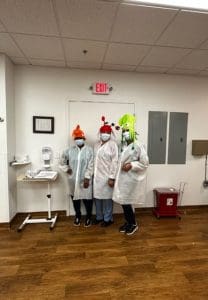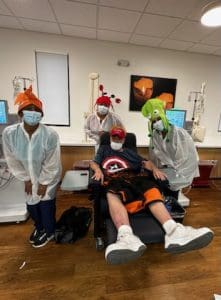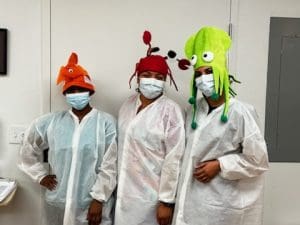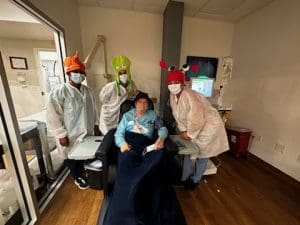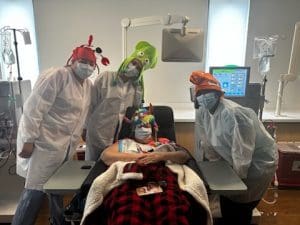Sharon A. Zalemski, MS, RD, CDN
Registered Dietitian at Pure Life Renal of Buffalo
When disease seriously damages the kidneys, it affects its ability to filter the blood and remove waste products and excess fluids. Kidney failure can be treated with hemodialysis, peritoneal dialysis or a kidney transplant. Dialysis is one part of the treatment plan. A kidney friendly diet is needed to help manage the balance of fluids and minerals including sodium, potassium and phosphorus. A kidney friendly diet is designed to provide the right amount of protein, calories, minerals, vitamins and fluid in your diet.
The kidney friendly diet has many factors to consider. One way to make it easier is to prepare foods from fresh ingredients. Preparing meals from fresh ingredients helps you avoid additional sources of sodium, phosphorus or potassium from additives in processed foods and allows room to enjoy a variety of foods.
 The protein foods you eat are used in the body for building muscles, repairing tissue and preventing or fighting infection. Protein foods include eggs, dairy products, meat, fish, poultry, nuts and nut butters and beans. Dialysis patients need to consume more protein to replace the protein lost during the treatment. When planning a meal, include 3- 4 oz of a high protein food. Try to include a source of protein at each meal. For example, herbed omelet and toast for breakfast can start your day with a high quality protein food. Homemade old fashioned pancakes and a homemade pan sausage can be a kidney friendly breakfast option as well. Dialysis days can be busy and some people are tired after receiving hemodialysis. Eating protein foods after dialysis is especially important to restore your body. Consider using leftover roasted vegetables and roast beef to prepare a tasty Mediterranean Panini or adding leftover chicken to a vegetable or pasta salad. Take time to prepare a favorite meal with extra servings. These extra servings can be frozen or heated up for a quick meal on another day.
The protein foods you eat are used in the body for building muscles, repairing tissue and preventing or fighting infection. Protein foods include eggs, dairy products, meat, fish, poultry, nuts and nut butters and beans. Dialysis patients need to consume more protein to replace the protein lost during the treatment. When planning a meal, include 3- 4 oz of a high protein food. Try to include a source of protein at each meal. For example, herbed omelet and toast for breakfast can start your day with a high quality protein food. Homemade old fashioned pancakes and a homemade pan sausage can be a kidney friendly breakfast option as well. Dialysis days can be busy and some people are tired after receiving hemodialysis. Eating protein foods after dialysis is especially important to restore your body. Consider using leftover roasted vegetables and roast beef to prepare a tasty Mediterranean Panini or adding leftover chicken to a vegetable or pasta salad. Take time to prepare a favorite meal with extra servings. These extra servings can be frozen or heated up for a quick meal on another day.
Your body needs calories from food to provide energy. Calories should be consumed in an amount to achieve or maintain a healthy weight and allow you to perform your daily activities and work. The Dialysis-Friendly My Plate is a guide available from your dietitian that can be used to help you plan a balanced meal including protein foods, fruits, vegetables and starches.
Sodium, Potassium and Phosphorus are minerals found in the diet. Foods that contain a high amount of sodium and salt can increase thirst and cause you to retain fluids. This can increase your blood pressure and increase the fluid weight gain between dialysis. It is important to reduce your intake of salt and foods high in sodium. Choose fresh foods and cook with herbs and spices in place of salt. You want to avoid use of salt substitutes made with potassium. Use the food labels to find the amount of sodium in a serving and choose items with 200 mg or less per serving.
Potassium is found in a variety of foods such as fruits, vegetables, meats, nuts, milk, dried peas and beans and dried fruit. It is important to maintain potassium within a safe range. Too little or too much potassium can be dangerous to your heart. Your dietitian will work with you to plan a diet to control potassium. An individualized plan can allow you to include some of the foods you enjoy. Potassium control requires choosing the right foods and consuming the proper portion of the food. The process of leaching can help reduce the potassium from vegetables such as potatoes or yams. Leaching will not remove all of the potassium in the vegetable. Talk to your dietitian to know the amount of the vegetable you can include in your diet.
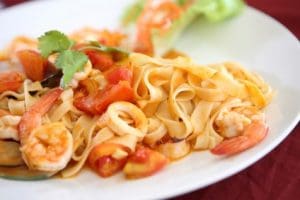 Phosphorus is found in all foods. Protein foods such as meats, milk, cheese, nuts, dried peas and beans contain higher amounts of phosphorus. Phosphorus is also added to foods in food processing. Check the food label ingredients to see if an additive with “phos” in the name has been added to the food. Control of phosphorus is important to maintain bone health. Diets containing large amounts of phosphorus will cause the phosphorus level to rise in the blood and cause calcium to be pulled from the bones. A loss of calcium in the bone can cause your bones to weaken and break easily. A kidney friendly diet will limit the amount of phosphorus in the diet. Choosing fresh foods instead of ready-to-eat or convenience foods can lower the phosphorus consumed in the diet. For many people, it may be necessary to take a phosphate binding medication at meals and snacks to help reduce the amount of phosphorus in the blood. The dose of the phosphate binding medication will depend on the amount of phosphorus consumed at a meal.
Phosphorus is found in all foods. Protein foods such as meats, milk, cheese, nuts, dried peas and beans contain higher amounts of phosphorus. Phosphorus is also added to foods in food processing. Check the food label ingredients to see if an additive with “phos” in the name has been added to the food. Control of phosphorus is important to maintain bone health. Diets containing large amounts of phosphorus will cause the phosphorus level to rise in the blood and cause calcium to be pulled from the bones. A loss of calcium in the bone can cause your bones to weaken and break easily. A kidney friendly diet will limit the amount of phosphorus in the diet. Choosing fresh foods instead of ready-to-eat or convenience foods can lower the phosphorus consumed in the diet. For many people, it may be necessary to take a phosphate binding medication at meals and snacks to help reduce the amount of phosphorus in the blood. The dose of the phosphate binding medication will depend on the amount of phosphorus consumed at a meal.
Your fluid allowance will depend on your kidney function. If you continue to make a small amount of urine, you may be allowed 1500 ml (48 oz) of fluid a day. If you no longer make urine, it is necessary to limit fluid sources to 1000 ml (32 oz) a day. Fluid build up can lead to shortness of breath, swelling in your legs, high blood pressure, damage to your heart, dizziness, nausea, headaches and cramping. Strive to limit fluid weight gain to 2-3 kg (4-6 lbs) between dialysis treatments. You will feel better when less fluid is removed from your body during your dialysis treatment. Fluids include anything that is a liquid. Plan your day to allow 4-8 oz of a beverage at a meal. Try to take your medication with the fluid at the time of your meal. Fluid intake must include your beverages and fluid from soups, gelatins, ice, ice cream, popsicles and nutritional supplements. Dry mouth and thirst make it hard to limit fluids. Think about your food choices. Salty or spicy foods can increase your thirst. If you are thirsty, try chewing on sugar-free gum, sucking on sugar-free hard candy or sucking on frozen fruits such as grapes to moisten your mouth.
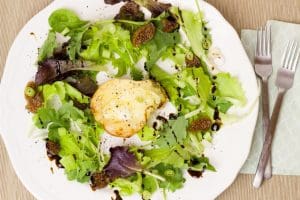 Meal planning can help to insure you are eating foods to meet your needs and maintain safe blood levels. A renal vitamin may be recommended if your food choices limit sources of important vitamins. Hemodialysis patients should take the renal vitamin after their dialysis treatment. Meals can be interesting and tasty. There are a variety of cookbooks for kidney patients. A list can be found on the National Kidney Foundation website (www.kidney.org). Recipe ingredients will be adjusted to control the amount of sodium, potassium and phosphorus in a serving. Perhaps you would enjoy a crispy oven fried chicken with a lemony orzo salad , coleslaw and pineapple upside down cake. If you enjoy barbequed chicken, a homemade spicy barbeque sauce can be the taste you are looking for. Seasonal foods can be enjoyed such as a pear and arugula salad. A kidney friendly dish is great to bring to a social event to allow you a safe food choice and share with others. Be adventurous and try a new recipe. Consider making one of the sample recipes provided. If you plan meals, keep a notebook of menus, recipes or foods that you enjoyed and refer to it for future meals. Your kidney friendly diet can help you feel better. Talk to your renal dietitian to develop a plan to keep your blood levels within the acceptable range and to include foods you enjoy.
Meal planning can help to insure you are eating foods to meet your needs and maintain safe blood levels. A renal vitamin may be recommended if your food choices limit sources of important vitamins. Hemodialysis patients should take the renal vitamin after their dialysis treatment. Meals can be interesting and tasty. There are a variety of cookbooks for kidney patients. A list can be found on the National Kidney Foundation website (www.kidney.org). Recipe ingredients will be adjusted to control the amount of sodium, potassium and phosphorus in a serving. Perhaps you would enjoy a crispy oven fried chicken with a lemony orzo salad , coleslaw and pineapple upside down cake. If you enjoy barbequed chicken, a homemade spicy barbeque sauce can be the taste you are looking for. Seasonal foods can be enjoyed such as a pear and arugula salad. A kidney friendly dish is great to bring to a social event to allow you a safe food choice and share with others. Be adventurous and try a new recipe. Consider making one of the sample recipes provided. If you plan meals, keep a notebook of menus, recipes or foods that you enjoyed and refer to it for future meals. Your kidney friendly diet can help you feel better. Talk to your renal dietitian to develop a plan to keep your blood levels within the acceptable range and to include foods you enjoy.
References:
1. Kidney Cooking a Family Recipe Book for Kidney Patients Third Edition 2013: free download from National Kidney Foundation Georgia Division Online.
2. Kidney Community Kitchen and Dietitian Blog: https://www.kidneycommunitykitchen.ca/kkcookbook/

